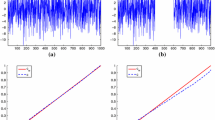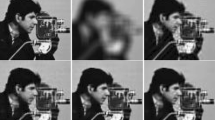Abstract
We present a Maximum Entropy based approach to the restoration ofdegraded images as an alternative to restorationtechniques using inverse Wiener filtering.The method we discuss applies in particularto images corrupted by a relativelyhigh system noise. A variety of experimental results supportingour imaging model are included.
Similar content being viewed by others
References
D.L. Angwin and H. Kaufman (1991), Non homogeneous image identification and restoration procedures, Springer Series in Information Sciences, vol. 23, 177–208.
Ch. Auyeung and R.M. Mersereau (1991), A dual approach to signal restoration, Springer Series in Information Sciences, vol. 23, 21–56.
J.M. Borwein and A.S. Lewis (1991), Duality relationships for entropy-like minimization problems, SIAM J. Control Optimiz. 29 325–338.
J.M. Borwein, A.S. Lewis and D. Noll, Maximum entropy reconstruction using derivative information, part I: Fisher information and convex duality, Math. of Operations Research, 21, 1996, 442–468.
J.M. Borwein, A.S. Lewis, M.N. Limber and D. Noll, Maximum entropy reconstruction using derivative information, part II: Computational Results, Numerische Mathematik, 69, 1995, 243–256.
B. Buck and V.A. MacAuley (1991), Maximum Entropy in Action, Oxford Science Publ., Oxford.
S.F. Burch, S.F. Gull and J.K. Skilling (1983), Image restoration by a powerful maximum entropy method. Computer Vision, Graphics, and Image Processing23, 113–128.
J.P. Burg (1967), Maximum Entropy Spectral Analysis, 37th meeting of the Society of Exploration Geophysicists, Oklahoma City.
D. Dacunha-Castelle and F. Gamboa (1990), Maximum d’entropie et problème des moments, Ann. Inst. Henri Poincaré26, 567–596.
A. Decarreau, D. Hilhorst, C. Lemaréchal and J. Navaza (1992), Dual methods in entropy maximization: Application to some problems in crystallography, SIAM J. Optimization 2 {pp173–197}.
J.E. Dennis jr. and R.B. Schnabel (1983), Numerical Methods for Unconstrained Optimization and Nonlinear Equations. Prentice Hall Series in Computational Mathematics.
T.S. Durrani and C.E. Goutis (1990), Optimization techniques for digital images reconstructed from their projections, IEEE Proc. Part E, 161–169.
R. Fletcher (1987), Practical Methods of Optimization, John Wiley & Sons, New York.
B.R. Frieden (1972), Restoring with maximum likelihood and maximum entropy. J. Opt. Soc. Amer. G2, 511–518.
L. Grippo, F. Lampariello and S. Lucidi (1986), A non monotone line search technique for Newton’s method, SIAM J. Numer. Anal. 23, 707–716.
Gull, S.F. (1989), Maximum Entropy and Bayesian Methods, vol 13, pp. 53–171, ed. by J.K. Skilling, Kluwer.
C.G. Han, P.M. Pardalos and Y. Ye (1992), Implementation of interior point algorithms for some entropy optimization problems, Optimization and Software1, 71–80.
R.M. Haralick, E. Østevold and X. Zhuang (1987), A differential equation approach to maximum entropy image reconstruction. IEEE Trans. Acoust. Speech Signal Processing35: 208–218.
Hunt, B.R. (1972), Deconvolution of linear systems by constrained regression and its relationship to the Wiener theory, IEEE Trans. Autom. Contr., 703–705.
E.T. Jaynes (1968), Prior probabilities, IEEE Transactions on Systems, Science and Cybernetics SSC-4, 227–241.
E.T. Jaynes (1982), On the rationale of maximum entropy methods, Proc. IEEE, Special issue on spectral estimation, vol. 70, 939–952.
R.W. Johnson and J.E. Shore (1984), Which is the better entropy expression for speech processing: —S log S or log S? IEEE Transactions on Acoustics, Speech and Signal Processing, ASSP-32, 129–137.
A.K. Katsaggelos and K.-T. Lay (1991), Maximum Likelihood Identification and Restoration of Images Using the Expectation-Maximization Algorithm, Springer Series in Information Sciences, vol. 23, 143–176.
D.C. Liu and J. Nocedal (1989), On the limited memory BFGS update for large scale optimization, Math. Programming 45, 1989, 503–520.
J.H. McClellan and S.W. Lang (1982), Multi-dimensional MEM spectral estimation, Spectral Analysis and Its Use in Underwater Acoustics, 10.1–10.8, Imperial College, London, U.K., Institute of Acoustics.
D. Noll (1995), Rates of convergence for best entropy estimates, Statistics and Decisions, 13, 1995, 141–165
D. Noll, Consistency of a nonlinear deconvolution method with applications to image restoration, Advances in Mathematical Sciences and Applications, to appear.
Author information
Authors and Affiliations
Rights and permissions
About this article
Cite this article
NOLL, D. Restoration of Degraded Images with Maximum Entropy. Journal of Global Optimization 10, 91–103 (1997). https://doi.org/10.1023/A:1008206503818
Issue Date:
DOI: https://doi.org/10.1023/A:1008206503818




